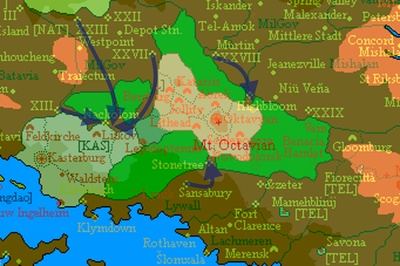Fall Schwartz-Tilman
Fall Schwartz-Tilman (Case Schwartz-Tilman) was a major Shirerithian offensive launched into the so-called Inner Benacian Quarantine Zone which commenced on 08.VIII.1659, with Shirerithian forces converging upon Nackholm from three directions on the evening of 24.VIII.1659. The attack, which followed in the wake of a previous raid against the Ben Mavet Organisation, was interpreted as a response to the establishment of contact the armies of Kalgachi and Kasterburg, obliging the Imperial Forces and Benacia Command to improve the position of their frontier garrisons in response. Officially the purpose of the operation was to break up a number of tee-al ranges along the border with Batavia. Concurrent with the main offensive, the Imperial Republic also launched attacks against the communes of Highbloom and Stonetree with a view to occupying the ruined cities and establishing new communication corridors connecting to Kalgachia.
| Fall Schwartz-Tilman | ||||||||
|---|---|---|---|---|---|---|---|---|
| Part of Benacian Reconquest | ||||||||
 Overview of the Shirerithian plan |
||||||||
|
||||||||
| Belligerents | ||||||||
| ||||||||
| Commanders and leaders | ||||||||
| Units involved | ||||||||
| Strength | ||||||||
| ||||||||
Nackholm Campaign
Highbloom Campaign
Stonetree Campaign
Aftermath
The occupation was not formally recognised by the international community which objected, amongst other things, to the bisecting of the green into smaller enclaves that would effectively be at the mercy of the Imperial Republic. After the failure of the invading forces to successfully pacify the region, the Imperial Republic reluctantly began to recognise the exercise of self-government by the surviving communities of Inner-Benacia.
The destruction of the Iggud by the Shirerithian III Corps opened the way for Jingdaoese backed Batavian settlers to enter and occupy Nackholm, paving the way for another wave of massed bomber raids on the battered settlements of the western pocket in retaliation by Imperial commanders furious at seeing dissident fighters slip into the territory under their noses.
The institution by the Batavian settlers of a system of apartheid discriminating against the Yehudi and residual Deep Singers of the region provided the Imperial Republic with a pretext to resume its intervention in early 1660, leading to the establishment of the Siyacha Free State, a loose protectorate nominally under the control of a Yehudi collaborationist government, centred around Nackholm.